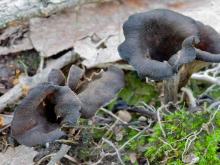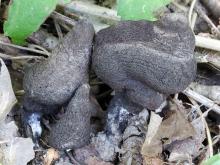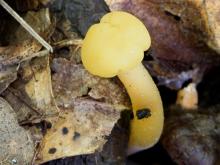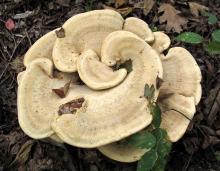Mushrooms
Media

Species Types
Scientific Name
Craterellus cornucopioides (C. fallax)
Description
The black trumpet is dark brown to black, vase- or trumpet-shaped, with a wavy margin and no gills. It grows in groups of few to many on rocky, mossy hillsides in deciduous woods.
Media

Species Types
Scientific Name
Hericium erinaceus
Description
The bearded tooth is a beardlike, whitish mass that grows on trunks of living deciduous trees and on fallen trees and logs.
Media

Species Types
Scientific Name
Hydnum repandum (Dentinum repandum)
Description
The hedgehog mushroom has an irregularly shaped, dull orangish tan cap, with spines or "teeth" on its underside. It grows on the ground in mixed woods.
Media

Species Types
Scientific Name
Tremellodendron pallidum
Description
The jellied false coral is a branching, whitish, leathery, coral-like jelly fungus. It grows on the ground in deciduous or mixed woods.
Media

Species Types
Scientific Name
Artomyces pyxidatus (formerly Clavicorona pyxidata)
Description
The crown-tipped coral is a many-branched, coral-like mushroom that is yellowish tan with crownlike tips. It grows on the dead wood of deciduous trees.
Media

Species Types
Scientific Name
Phallus ravenelii
Description
Ravenel's stinkhorn is a long, whitish column with a greenish, smelly slime covering the top, and a whitish or pinkish cup around the base. It grows on wood debris, mulch, rotted stumps, and sawdust, and in deciduous woods.
Media

Species Types
Scientific Name
Xylaria polymorpha
Description
Dead man’s fingers is a black, distorted, clublike or finger-shaped fungus with a wrinkled, charcoal-like surface. It grows in clusters at the base of rotting deciduous trees and stumps.
Media

Species Types
Scientific Name
Leotia lubrica
Description
The jelly baby is a small mushroom with a gelatinous, orangish yellow stalk and head. It grows in groups on soil in mixed woods.
Media

Species Types
Scientific Name
Bondarzewia berkeleyi
Description
Berkeley’s polypore grows in rosettes or clusters of fleshy, cream-colored caps, with whitish pores that descend the stalk. Look for them on the ground near the bases of trees.
Media

Species Types
Scientific Name
Polyporus badius
Description
The black-footed polypore has a smooth, wavy brown cap with whitish or tannish pores on the underside and a black, smooth, off-center stalk. It grows singly or in groups of up to several on dead wood and stumps of deciduous trees.
See Also



Media

Species Types
Scientific Name
Monotropa hypopitys
Description
Pinesap is a plant that puts the "wild" in wildflower! It lacks chlorophyll, so its roots connect to fungi underground and absorb nutrients from the fungi.
Media

Species Types
Scientific Name
Cladophora, Pithophora, and Spirogyra spp., and others
Description
Filamentous green algae forms green, cottony masses that are free-floating or attached to rocks, debris, or other plants.
Media

Species Types
Scientific Name
Monotropa uniflora
Description
Indian pipe lacks chlorophyll, so it is white, not green. Below ground, its roots join with fungi that connect to tree roots. This plant, then, takes nourishment indirectly from the trees.
About Mushrooms in Missouri
Mushrooms are a lot like plants, but they lack chlorophyll and have to take nutrients from other materials. Mushrooms are neither plants nor animals. They are in a different kingdom — the fungi. Fungi include the familiar mushroom-forming species, plus the yeasts, molds, smuts, and rusts.
Always be cautious when eating edible mushrooms. Be absolutely sure of the ID, and only eat a small amount the first time you try it to avoid a reaction..





















